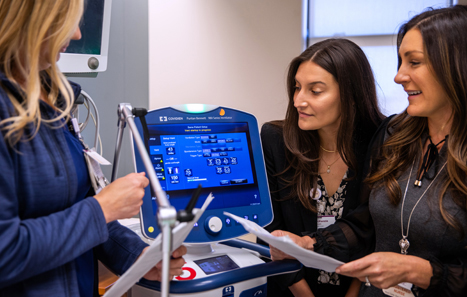Every day in the dozens of intensive care units (ICUs) across UPMC hospitals, patients in life-threatening circumstances get the quick and critical care they need. In situations where a patient has experienced respiratory failure or severe trauma, applying mechanical ventilation is essential to saving a life. But a growing body of evidence shows that it’s also important to get that same patient off the ventilator and out of the ICU as quickly as possible.
While ICUs exist to stabilize the most critically ill patients, the longer a patient is in the ICU, the more likely they are to face myriad physical and mental challenges after discharge; longer ICU stays are also associated with a higher mortality rate.
So how does a hospital system like UPMC, with 42 ICUs across multiple geographies, endeavor to reduce the average number of ICU days that patients in our hospitals face?
That’s the question that the ICU Service Center, a multidisciplinary team of researchers and clinicians who work to improve patient outcomes, set out to answer in early 2023. While there are many factors that contribute to the length of a patient’s ICU stay, the ICU Service Center team needed to identify a strategy that would make a significant difference and could be implemented effectively systemwide.
The answer, they decided, was to pursue a yearlong mechanical ventilation quality improvement program, involving spontaneous breathing trials (SBT), spontaneous awakening trials (SAT), and lung protective ventilation (LPV) metrics. When these measures are implemented appropriately and in tandem with one another, critically ill patients requiring mechanical ventilation will spend less time, on average, on ventilators. And in most instances, the sooner a patient can be “liberated” from a ventilator, the sooner they can leave the ICU.
As a leading research institution and health care system with a large geographic footprint, UPMC is uniquely positioned to apply the research it has pioneered globally in a clinical setting.
“UPMC has generated some of some of the most highly cited literature in the mechanical ventilation space,” said Chenell Donadee, MD, MBA, senior medical director, UPMC ICU Service Center. “One of the things that makes the ICU Service Center stand out is not only defining what is best practice, but actually implementing it.”
Putting Theory Into Practice
The ICU quality improvement program leveraged a machine-learning-based, risk-adjustment model developed in the Lab for Computational Physiology at Massachusetts Institute of Technology (MIT). Put simply, the model helps to analyze and understand the risk factors of patient care by considering the different levels of illness severity among patients in the ICU, allowing for better decision-making. It’s like having a smart assistant that can process a lot of medical data quickly and accurately to help nurses and doctors make decisions that optimize care.
“Our team was the first in the world to incorporate this model into an informatics pipeline, allowing us to more easily leverage the breadth of data available at UPMC,” said Christopher Horvat, MD, director, Clinical Informatics, ICU Service Center. “An incredibly small percentage [of these models] are actually deployed in a medical setting, so when we showed MIT what we had done with the model, they were really excited to see that it was being used to improve patient care.”
The ICU Service Center team had laid the groundwork for a transformative project: They honed their focus to mechanical ventilation, a strong area of research for UPMC. They identified a machine learning-based model to power a quality improvement program at scale.
But their next challenge was one of implementation. “UPMC is a fantastic research institution,” said Dr. Donadee. “But great science can’t just ‘sit there.’ You have to connect the research to the patient and the bedside.”
The “patient and the bedside,” in this case, meant patients across 42 UPMC ICUs. The enormous scale of this challenge cannot be understated: Besides having separate leadership and personnel, each ICU has its own specialties and follows unique standard operating procedures. Targeted education would be required for all teams involved: respiratory therapy, nursing, physicians, and advanced practice providers.
Furthermore, though all ICUs are part of UPMC, many currently operate on different electronic health records (EHRs), ranging from Cerner to Meditech to Epic. “[While] there’s opportunity and clear benefit to the system size, there are also challenges related to the heterogeneity of the data landscape that we had to overcome to do this,” said Dr. Horvat.
Collaboration Across Disciplines and Regions
The ICU Service Center team understood that successful implementation — which they defined as 90% compliance across all UPMC ICUs — would be a multidisciplinary effort, involving not only the health care workers who treat critically ill patients, but also hospital leadership to rally support for the initiative, as well as IT and informatics teams to ensure data integrity across multiple separate EHRs.
Members of the ICU Service Center team deployed to each hospital and ICU to rally support for the project. “We connected with every single one of the leadership teams at these hospitals to ensure that we were in lockstep and moving toward the same goal,” said Aimee Boeltz, DNP, senior director, clinical operations, ICU Service Center. “Sharing the ‘why’ [of the quality improvement program] with them was important. This is not about cost savings for UPMC; this is about improving patient outcomes, which is highly motivating to our audience.”
To further motivate disparate teams, the ICU Service Center and Clinical Analytics collaborated to build a digital dashboard to monitor the progress of the quality improvement program at each ICU across the UPMC system. All hospitals had access to the dashboard, which helped them measure the success of their efforts compared to other ICUs. It helped foster a sense of camaraderie — and perhaps a bit of friendly competition too. “Say one ICU was having a challenge,” said Dr. Donadee. “They could look at the dashboard and say to themselves, ‘If that hospital can obtain those results, why can’t we?’”
And the results achieved over the course of the year are staggering. Between January and December 2023, UPMC ICUs realized a collective risk-adjusted reduction of 2,483 patient ventilator days. That number adds up to nearly seven years of time that patients in UPMC ICUs were not on ventilators when they did not have to be. And, while these metrics are measured at the “population level” and not adjusted to account for specific cases and those unique needs, it’s not hard to imagine how the results may translate into better overall patient outcomes and better standards of care.
When critically ill patients can safely breathe on their own, they are one step closer to leaving the ICU. Given that each day a patient spends in the ICU increases their risks for hospital-acquired infections, physical challenges associated with extended immobility, and psychological stress — a set of conditions collectively referred to as post-intensive care syndrome, or PICS — the implications of this effort are much more far-reaching.
One of the most notable achievements of the ICU Service Center’s quality improvement program was the fact that it was successfully implemented at every ICU across the UPMC system, not just the largest or most sophisticated among them. The ICU Service Center’s goal of reaching more than 90% program compliance across all ICUs, was met — and in many cases, exceeded. And this work is ongoing: Each day, patients in UPMC ICUs are safely transitioned off mechanical ventilators sooner than they would otherwise be because of this new standard of care.
Better still, the ICU Service Center’s initiative laid the groundwork for future quality improvement programs, particularly from a data and informatics perspective. “Our success has been human, but it’s also closely coupled with both electronic workflows and the data to support performance,” said Dr. Horvat. “And it’s only going to get more streamlined as our system transitions to a single electronic health record with UPMC Bridges.”
The success of the ICU Service Center’s 2023 quality improvement program showcases the degree to which multidisciplinary and systemwide collaboration is essential at UPMC. It demonstrates UPMC’s ability to translate scientific evidence into clinical practice at a large scale using both change management and machine learning tactics.
And it serves as a shining example of UPMC’s mission: To provide outstanding patient care and to shape tomorrow’s health system through clinical and technological innovation, research, and education. The program resulted in an estimated cost reduction of $6.2 million dollars: proof positive that improvements that are focused on outcomes can also help to reduce costs and sustain the organization’s mission long-term.
“Everyone is here at UPMC because they want to help patients,” said Dr. Donadee. “While the program required substantial effort from everyone involved — clinical teams, leadership, informatics — ultimately, it was the impact to patients that everyone rallied around.”
Note: some links are only accessible for UPMC employees and will not open for external readers.









